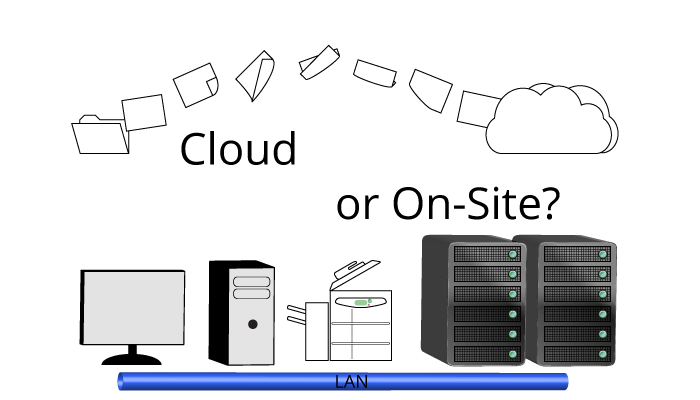 As cloud computing and storage capabilities become more powerful and more affordable, many companies are beginning to question whether they should be abandoning on-premises systems in favor of off-site solutions. “What’s right for my organization?” they ask. As is typically the case with document management solutions and software, the answer is “It depends.” Specifically, it depends on your requirements and your resources.
As cloud computing and storage capabilities become more powerful and more affordable, many companies are beginning to question whether they should be abandoning on-premises systems in favor of off-site solutions. “What’s right for my organization?” they ask. As is typically the case with document management solutions and software, the answer is “It depends.” Specifically, it depends on your requirements and your resources.
The Case for On-Premises Document Management Solutions
Although people are increasingly looking “cloudward” for their processing and data storage, for some organizations it is better to keep those functions in-house. An on-premises solution may be right for you if you:
- Have large numbers of files. Server-based storage prices have been dropping consistently for many years, making on-site storage very affordable. If you handle terabytes of data, it’s possible that an on-premises content management solution will be to your financial advantage.
- Already have infrastructure in place. If you have the servers, software licenses, and staff you need to manage your documents in-house, switching to a cloud-based solution may not make sense. As long as you are using current technology and have solid disaster recovery procedures in place, you can simply continue to expand your storage as needed.
- Work with very large files. The performance of cloud-based solutions continues to improve, but if you are working with especially large documents like AutoCAD files, detailed maps, etc., an on-premise system will serve up those files noticeably faster.
- Work with sensitive information. While cloud-based systems typically have top-notch security, your clients may have requirements about data security that are best met with an in-house solution.
The Case for Cloud-Based Document Management Solutions
On-premises content management software has its advantages, but a web-based solution is optimal in some scenarios, including if you:
- Don’t have IT staff. Many organizations choose to run lean by outsourcing their IT, both from a personnel and a technology perspective. If that’s you, a cloud-based solution can give you the storage capacity you need without having to hire a team to manage it.
- Have a large number of users. The more users you have, the more work it is to keep them connected to an on-site solution. With the web, on the other hand, users simply need a current web browser to access documents.
- Have a geographically dispersed workforce. It’s becoming more and more common that an organization’s team is connected by technology rather than proximity. If your staff members work from home or from different offices around the country, a cloud-based content management system makes it easy for them to get the information they need.
The Case for Hybrid Document Management Solutions
Having made the case for the two approaches above, I should point out that your method of document management doesn’t have to be based exclusively on cloud or on-premises technology. You can certainly develop a solution that takes advantage of the best properties of both approaches.
The goal is to craft the document management solution that allows your organization to work most efficiently and effectively.
About the Author
 Charles Weidman is the President and CTO of Buddha Logic. Charlie has over two decades of experience in the design, development and implementation of content services and business process management solutions. He is also an expert in robotic process automation. Charlie founded Buddha Logic with the idea that well-architected digital document capture and management processes are both beautifully simple and powerfully logical. Find and connect with Charlie on LinkedIn.
Charles Weidman is the President and CTO of Buddha Logic. Charlie has over two decades of experience in the design, development and implementation of content services and business process management solutions. He is also an expert in robotic process automation. Charlie founded Buddha Logic with the idea that well-architected digital document capture and management processes are both beautifully simple and powerfully logical. Find and connect with Charlie on LinkedIn.
